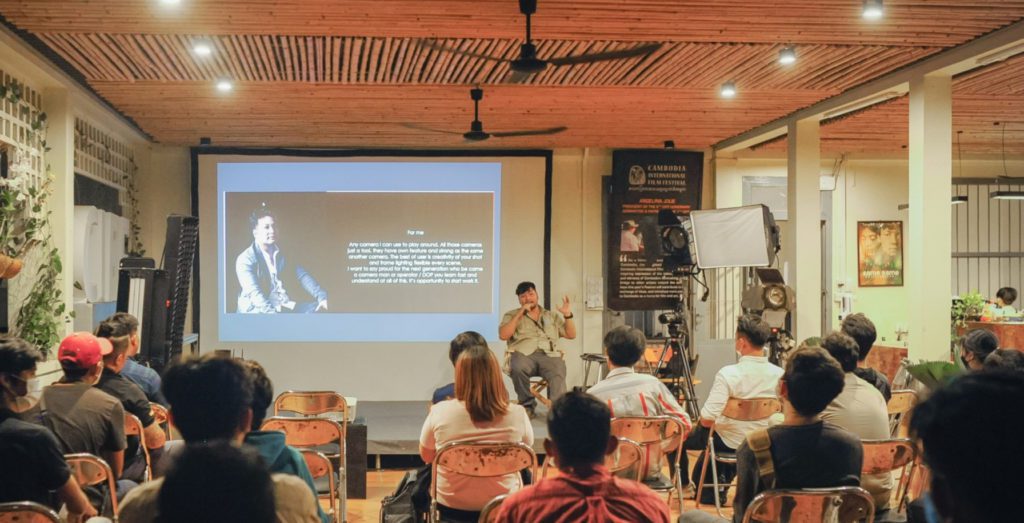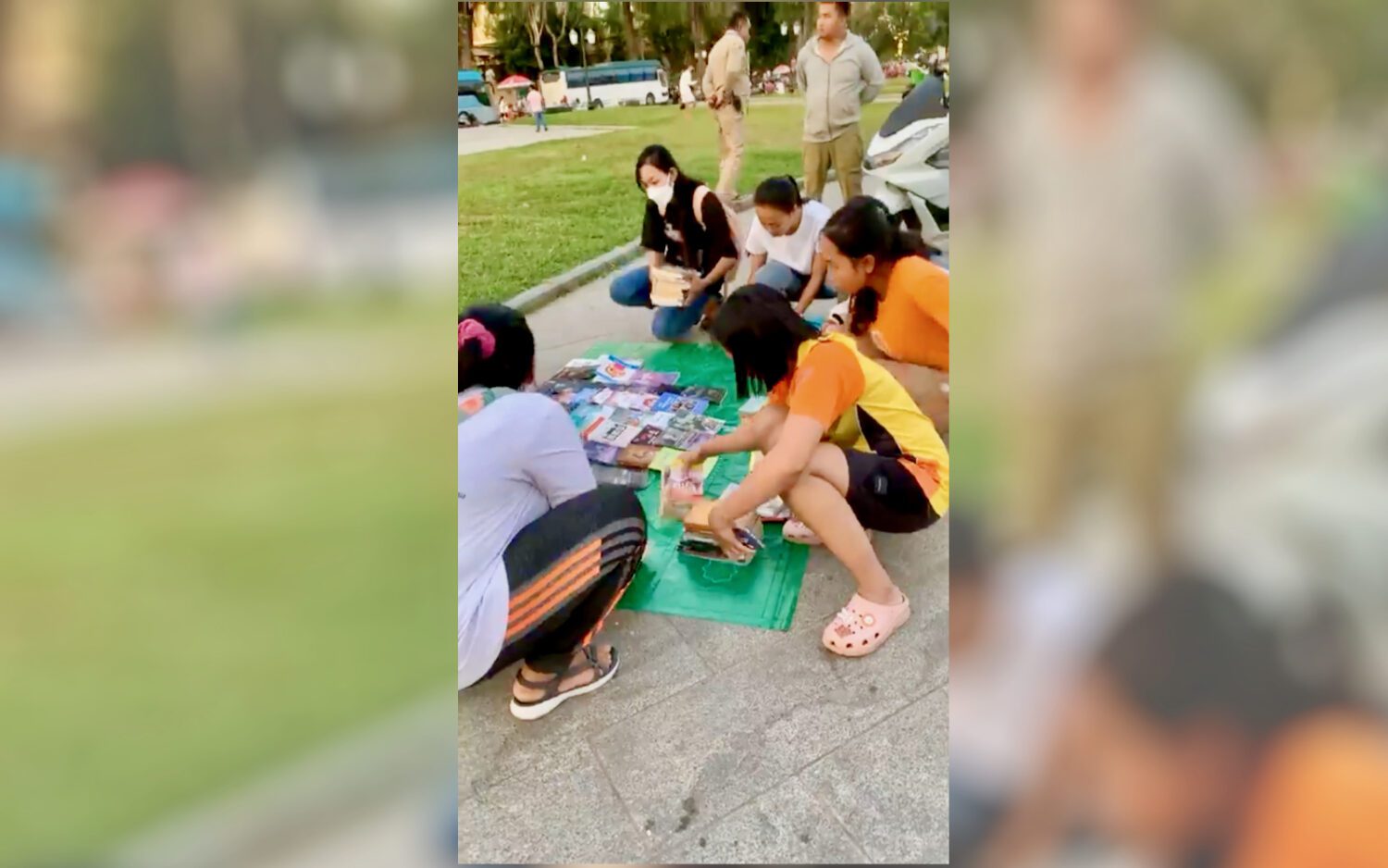Most people traveling down Phnom Penh’s Street 200 see it as just another unassuming downtown thoroughfare; a small stretch of buildings they breeze past on their way to someplace else. But Chandara So sees it differently. He sees it as the exciting center of a new Cambodian renaissance, soon to be filled with Cambodian and foreign movie lovers walking from exhibition to exhibition.
It may not be visible today, but it isn’t just a fantasy either. With the opening of Cine Hub, there are now four places to catch a movie within a one block radius. Chandara and Kimlong Meng, the two founders of Cine Hub, hope to see this number only go up.
Cine Hub is a new space on the second floor of the Cambodia Film Commission building, and is intended to help up-and-coming Cambodian filmmakers connect with one another and obtain access to resources they might otherwise not be able to afford. Founded by some of the organizers of the Cambodian International Film Festival, this large terrace seating area is already sponsoring screenings, networking events, and masterclasses with established Cambodian filmmakers.
Nights have included free screenings of Cambodian and foreign films, as well as seminars on subjects like special effects makeup, or cinematography on a budget. During the day, they allow small-budget productions to use their space as a filming area, or use their editing suites.
By opening a nurturing space, they believe they are helping to foster a globally relevant Cambodian cinema scene. While some might have a hard time seeing Phnom Penh as the next L.A., there is good reason to believe it’s possible. After all, it wouldn’t be the first time.
“We were once a nation of cinephiles,” Chandara said earlier this month. Hundreds of films were produced locally during the post-independence era often referred to as modern Cambodia’s “Golden Age.” Cambodian productions such as The Snake King’s Wife were hugely popular both in the country and abroad, particularly in neighboring Thailand. Ordinary Cambodians, including Chandara’s mother, went to one of the many cinemas that dotted Phnom Penh in those days, sometimes more than once a week. His mother fondly recounted to him that when they went to see Cambodian legends on the silver screen, they felt like they knew who they were.
Long before Prince Norodom Sihanouk was selected to be the country’s next king, he had aspirations of being a filmmaker, and once he was crowned he did not forget the dreams of his youth. After the French withdrew in 1953, he used his influence as monarch to nurture the fledgling nation’s small film industry, and even directed and starred in dozens of movies himself. Many young Cambodians started taking up this new art form with royal approval.
“They didn’t really know how to make a movie,” Chandara said with a laugh. “But they knew they wanted to, so they brought equipment from different countries and started learning by doing.”
These upstart filmmakers soon established a Khmer cinematic language, and began congregating regularly to share their ideas in the long-since shuttered Cafe Sre Ambel (The Salt Field Cafe). There was nothing particularly special about this coffee shop, except that it happened to be located on the same street as the homes of many of Cambodia’s movie stars of the day. That street was Street 200, where Cine Hub just opened its doors.
Cine Hub is not the first to choose this symbolic location. The very same building also contains the Cambodia Film Commission, which assists foreign productions in shooting within the country. This is a bigger market than one might expect. For example, even though the recently released “Onoda: 10,000 Nights in the Jungle” was set in the Philippines, it was largely filmed in Cambodia. They also share the building space with Kudu Studios, a production house which specializes in aerial and underwater cinematography.
Directly across the road is the government’s department of cinema and cultural diffusion. A few doors down is the Bophana Audiovisual Resource Center, an archive of surviving footage and images from Cambodia’s past, founded by some of Cambodia’s biggest directors, such as Rithy Panh. The Bophana Center also hosts its own exhibitions and classes for aspiring filmmakers, such as training courses in documentary filmmaking for rural and minority group Cambodians.
One street over is Institut Francais’s “Le Cinema,” which mostly plays French films but also regularly screens Khmer productions with French subtitles. Like space dust gathering into a cloud before becoming a star, so far there is little unified structure to this increasingly vibrant neighborhood. But Chandara has started gathering support among his industry friends to ask that this section of Street 200 be renamed “Cinema Street,” and put it on the map both metaphorically and literally.

Already, a Phnom Penh movie lover can get their fix without having to walk more than a block from Cinema Street. This weekend, one can catch a screening of Sok Visal’s LGBTQ comedy “Poppy Goes to Hollywood” at Cine Hub, and next weekend see Sok Sothun’s “The Song of the Rice People” at Bophana Center. From the end of June through the beginning of July, Bophana, Cine Hub and Institut Francais will host free viewings of movies featured in this year’s Cambodia International Film Festival, along with other participating theaters around the city.
By having a public space in this area, Chandara believes that “filmmakers can meet and share challenges, and find solutions,” and by screening films for free, he seeks to encourage people to share their work with a test audience.
“We want people to know about the past,” Chandara said of his dreams to revitalize this street, and see it teeming with creative energy as it did before the Khmer Rouge. “But we can’t just copy the golden era: We have to have a new age.”
Unlike other film industries, which evolve naturally and build off of previous works incrementally, Cambodian cinema has had to start almost from scratch. Most of the golden-era filmmakers were brutally purged or forced into exile when Pol Pot’s forces took Phnom Penh in 1975. Film archives were destroyed or abandoned, leading to the loss of thousands of film reels containing decades of Cambodian artistic treasures. Even after the Khmer Rouge were ousted by the Vietnamese, the film industry was not able to recover for a long time.
“The people who survived had to think about getting rice on their plate,” Chandara explained. “Now we are past the stage of stability. We are at the stage where people want an identity.”
While films and TV shows have been produced in Cambodia for decades, high-value productions relied heavily on foreign resources and labor. According to Chandara, when foreign productions came to film in Cambodia, “They brought equipment from Vietnam and Thailand. They brought all the key departments from other countries. Cambodians just carried boxes.”
But this has slowly changed. Cambodian filmmakers have been steadily releasing horror movies and slapstick comedies which have been enjoyed by domestic audiences. Recently, some directors have branched out to other genres, including more serious dramas which have garnered international acclaim, such as the recently released White Building, which British newspaper The Guardian called a “modernist masterpiece.”

As of now though, these slow, pondering art house films have not been as popular domestically as their foreign counterparts, and local audiences still prefer the scary movies and slapsticks that account for most of Cambodia’s production today. But this does not concern Chandara, who thinks other genres will become popular too. “We gave them a different taste — they just need time to digest it.”
Chandara and his colleagues are confident that by creating regular film events, and seeking out the next generation of Cambodian filmmakers, Cinema Street will become a cultural powerhouse. One of these promising youths is Puthea Kimhan, an 18-year-old from Kampong Speu who dreams of being a producer. “Seventy percent of my friends went to study film abroad,” he said. “They looked for scholarships or internships in the U.S., in France, in Singapore, in Bangladesh.”
While his classmates believed they would have better luck in foreign film industries, Kimhan sees the rapid growth of the local one as providing more opportunities. “There is no limit,” he said. Though at first his parents were not convinced that he could have a career in Cambodian film, over the past two years he graduated from personal assistant to production coordinator, and plans to become a line producer in the future. Like his counterparts in California or Paris, he has aspirations of working on big productions. Perhaps one day he’ll get to tell how he got his start on Cinema Street.












